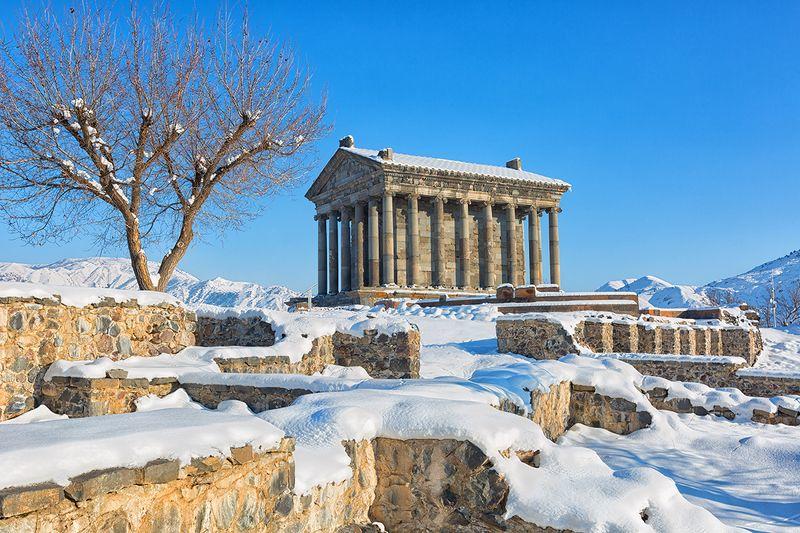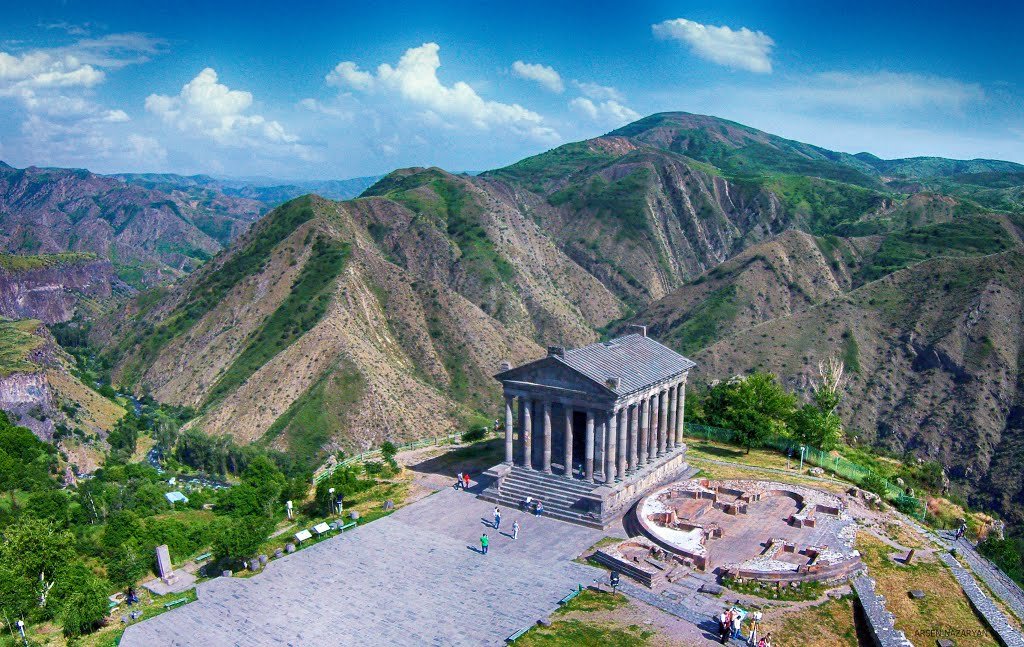The Temple of Garni
The Temple of Garni was constructed by Trdat I in the 1st century AD. The temple itself was built on top of an Urartian temple. So Trdat dedicated this temple to the sun goddess Mythra. That is why this temple is the true and unique masterpiece. Garni Temple is Armenia’s only Greco-Roman-style building. After the adoption of Christianity, it became the summer residence of Khosorovdukht, the sister of King Trdat III.
It is one of the most ancient landmarks in Kotayk and whole Armenia which has survived since pagan period.
In 2011 the complex received the prestigious award of the UNESCO-Greece Melina Mercouri International Prize.
Architecture of Garni Temple
- Canyon of the Azat river
- The Temple of Garni
The temple was built similar to the well-known Temple of Athena in Greece. So the structures of the fortress of Garni are in perfect harmony with the surrounding nature. Garni Temple stands on a triangular cape which dominates the locality and juts into the river.
Garni was designed according to the sacred geometry of the day. That is why it perfectly follows the Pythagorean and Platonic theories of sacred geometry in its design, a design for civilization carved from the wilderness. The temple’s facade is decorated by 24 slender Ionian columns crowned by the roof with a triangular pediment. The fortress was made from huge basalt stones and reinforced with 12 square towers. The total length of the 2.1meter walls is 314 m. Garni is distinguished by magnificent furnish. The stone cut ornaments, the bas-reliefs of kneeling human figures on a podium of the same temple, the basalt columns, the eaves, the capitals decorated with well-preserved carving showing grapevines, pomegranates and also other elements of ancient Armenian ornamentation testify about the high degree of development of sculpture in ancient Armenia.
The complex included disconnected buildings: a temple, a presence chamber, a columned tall, a residential block and also a bath-house.
The statue of Mythra stood inside the temple on the altar so everyone could see it while praying outside the building.
The temple was destroyed in 1679 in an earthquake.
The parts, fragments of graceful columns and also wall stones were spread all around the temple. This circumstance made possible the restoration of the temple which took place in the 1930s. The temple restored due to the skilled specialists and local residents. Because they had collected the pieces the destroyed building on the neighboring slopes for several years. However, Movses Khorenatsi ascribed the foundation of Garni to the grandson of Hayk Nahapet – Garnik – was named the temple of Garni.
The Bath house of Garni
The bath-house is situated in the northern part of the square. It is consists of 5 rooms, succeeding each other in the same direction. These rooms are:
- Dressing room;
- Cold water bath;
- Warm room;
- Hot water room;
- Steam Room.
The first room was the cloakroom of the bathhouse. The second and the third rooms served as bathrooms, the 2nd room – for cold water and as we understand the 3rd one – for warm water. The 4th room was the bathroom for hot water. In the north-western part of the temple was located the furnace meant for heating the water. And finally, the 5th room was for the steam room.
The most interesting part of the bath house is the mosaic dating back the third century. It is made of natural stones featuring 15 various colors. In spite of that, this 15-color natural stone-made mosaic floor is still preserved. The floor illustrates various sea images: deities, mermaids, fish-centaurs, etc. There are such phrases as “The Deep of the Sea”, “Sea Peace” in the illustrations. One inscription made in Koine Greek if translated word-for-word means, “we didn’t get even a dead fish from the sea or the ocean.” In other words, it would sound as follows, “We worked without any pay.”
The Fortress of Garni
There is no exact evidence as to when the fortress of Garni was founded. The fortress of Garni is situated in the village of the same name in the Abovian District. So Garni Fortress is one of the vivid evidence of the centuries-old culture of the pre-Christian period in Armenia. The fortress was erected in the 3rd – 2nd centuries BC. So the inhabitants of Armenia found the remains of a Bronze Ange fortress in the wall base. They very cleverly chose the place for building this fortress. The fortress was conquered by Argishti I, the king of Urartu, in the first half of the 8th century B.C.
In the epoch of the Armenian rulers of the Ervandids, Artashesids and Arshakids dynasties Garni was a summer residence of the kings and also the place where their troops were stationed.
The Location of Garni Temple
- Garni Temple
- Garni
The Temple of Garni is one of the oldest sights in Armenia worth to be seen once in a lifetime. Garni is on the road to Geghard and both can be comfortably seen on the same day. When you stand and look around, you see a whole band where the sweet and relieving sounds of symphonic metal. This metal makes you relax and enjoy the entire beauty opening in front of you.
On the road to Garni, you also can look at the Charents Arch. But the arch is not what you stop for. But for the great view of Ararat which it frames on a clear day.
Not far from Garni is located an electric station. The electric station is hidden from view by thick trees and greenery, and also several huge wilds rose bushes.
There is also an existing picnic area, which Armenian people or tourists visit very often.
And finally for visiting the Temple of Garni you have to pay. So for kids, it makes up 100 AMD (Armenian Dram), for adults- 250AMD. While for tourists it makes up 1000AMD. Guided tours are also available at 1500 Dram.
The Temple of Garni is open all year round. In summer- from 10am to 9pm, while in winter- from 10am to 5pm.













Leave a Comment